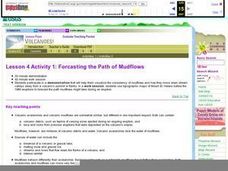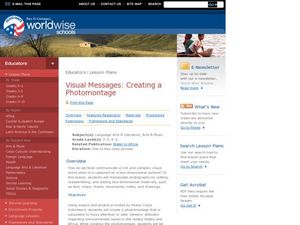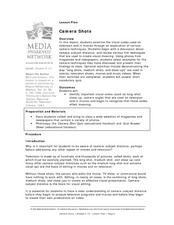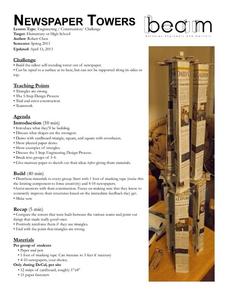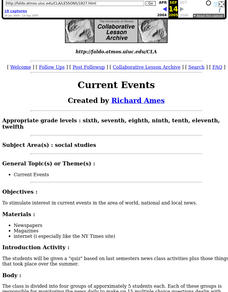Curated OER
Circles, Squares, Triangles and Rectangles In Our World
Here is an engaging geometry lesson which has students identify the properties of shapes and cut shapes out of magazines. They make cookies using cookie cutters in various shapes.
Curated OER
The Mass Media and Politics
What effect do the prevalence of televisions in homes have on the American political stage? Challenge your learners to consider this idea with these ten questions, both true/false and multiple choice. You could use this worksheet as a...
Curated OER
How Does News Influence Stock Prices?
Young scholars examine how economic news and business events can change the price of a stock. They see that the unexpected events that benefit or harm the company in turn move the company's stock price up or down.
Curated OER
Forcasting the Path of Mudflows
Students visualize consistency of mudflows and how they move down stream valleys away from a volcano's summit. They use topographic maps of Mount St. Helens before the 1980 eruptions to forecast the path mudflows might take during an...
Curated OER
Physical Activity Can Reduce Your Stress
Identify sources of stress in your students' everyday lives. They are introduced to ways in which they can relieve stress and consider the value of physical activity in overall health.
Curated OER
The Front Page: Asking Geographic Questions
Learners examine how to ask geographic questions. They read an article with details omitted, list possible geographic questions, and write a summary of the article.
Curated OER
Lesson 6 How Does News Influence Stock Prices?
Learners see that economic news and business events can change the price of a stock. They see that the unexpected events that benefit or harm the company, in turn, moves the company's stock price up or down.
Curated OER
That Is Not My Opinion!
Being an informed citizen requires distinguishing fact from opinion and understanding persuasion methods. Secondary learners evaluate newspaper editorials. They read opinion pieces, identify the writer's purpose and position on an issue,...
Curated OER
Fact V. Opinion
Students use statements out of newpapers to distinguish between facts and opinions. They discuss these differences as well.
Curated OER
What's Your Temperature?
Learners take a look at the local newspaper and focus on the weather section. They get into small groups, and each one looks at the same map, but of a different part of the country. They must prepare a presentation that shows how...
Curated OER
Near v. Minnesota
Students discuss what free press means and what it would be like without this right. They read the summary from the Near v. Minnesota case. In groups, they analyze a problem and report to the class.
Curated OER
Political Cartoons
Students examine a variety of historical cartoons. They recognize a political cartoon and identify the main idea, symbolism, exaggeration and caricature in political cartoons. Students analyze a political cartoon by Benjamin Franklin.
Curated OER
The Wetlands
Complete a comparison of the wetlands found in New York and Louisiana. Using various research methods, gather data on the wetlands found in New York and Louisiana, the animals, conditions, etc. Data is used to create a brief report on...
Curated OER
Staying Informed
Learners identify the various ways the American public can stay informed on the news. In groups, they brainstorm reasons why the public should not stick to one source for their news. They use this information to examine their own current...
Curated OER
Proud to Recycle Worksheet
In this recycling worksheet, students put a check mark next to the items from a list that are recycled in their local area. They determine which items are curbside recyclables and which are drop-off items. They examine pictures of...
Curated OER
Help Wanted: President of the United States
Students consider qualities and United States president should have. In this government lesson plan, students research the responsibilities of the president and use that information to create an advertisement that describes the job and...
Curated OER
Visual Messages: Creating a Photomontage
Students create a photomontage. For this lesson on photography as a means of conveying emotion, students use images gathered from the Internet to create a photomontage comparing how water is used in Africa and the U.S.
Curated OER
Career Connections: The Connection Corner
Students will create a career information center. In this careers lesson, students research careers on a local and national level and create a help wanted ad for an occupation of personal interest. Students create a...
Curated OER
Camera Shots
Understanding how visual codes such as long-shots, close-ups, and camera angles affect meaning helps prepare young filmmakers to plan their own productions. The concepts embedded could also be used to analyze photographs and paintings.
Virginia Department of Education
The Writing Process for Expository Writing
Struggling on what steps to take in your expository essay lesson? Or confused on what to include for your scribes? This exercise in the process of expository writing provides concepts and structure for the educator on what the writers...
Berkeley Engineering and Mentors
Newspaper Towers
The challenge is quite simple: build a tall tower from a predesignated number of newspaper sheets. Emerging engineers work in teams to build the tallest structure. You will demonstrate some structure shapes and discuss their relative...
Curated OER
Fun With Chicka Chicka Boom Boom
Students read the book Chicka Chicka Boom Boom and listen to the musical tape. Then they make their own coconut trees, adding their own letters. They express and record their favorite parts. All are displayed on a bulletin board.
Curated OER
Hatching Chickens
Students observe chickens hatching in a classroom incubation environment In this egg-hatching lesson plan, students make observations of the hatching process and later care for the hatched chickens.
Curated OER
Current Events
Here is an ongoing activity intended to build interest in local, national, and world news. The class is divided into four groups of approximately five students each. The groups are responsible for monitoring the daily news. They compose...





